Piolets d'Or Announces the "Significant Ascents" of 2023
This list of 68 climbs is effectively a "long list" used to select nominees of the prestigious alpine award.

“Those who overcome great challenges will be changed, and often in unexpected ways. For our struggles enter our lives as unwelcome guests, but they bring valuable gifts. And once the pain subsides, the gifts remain. These gifts are life's true treasures, bought at great price, but cannot be acquired in any other way.” ― Steve Goodier
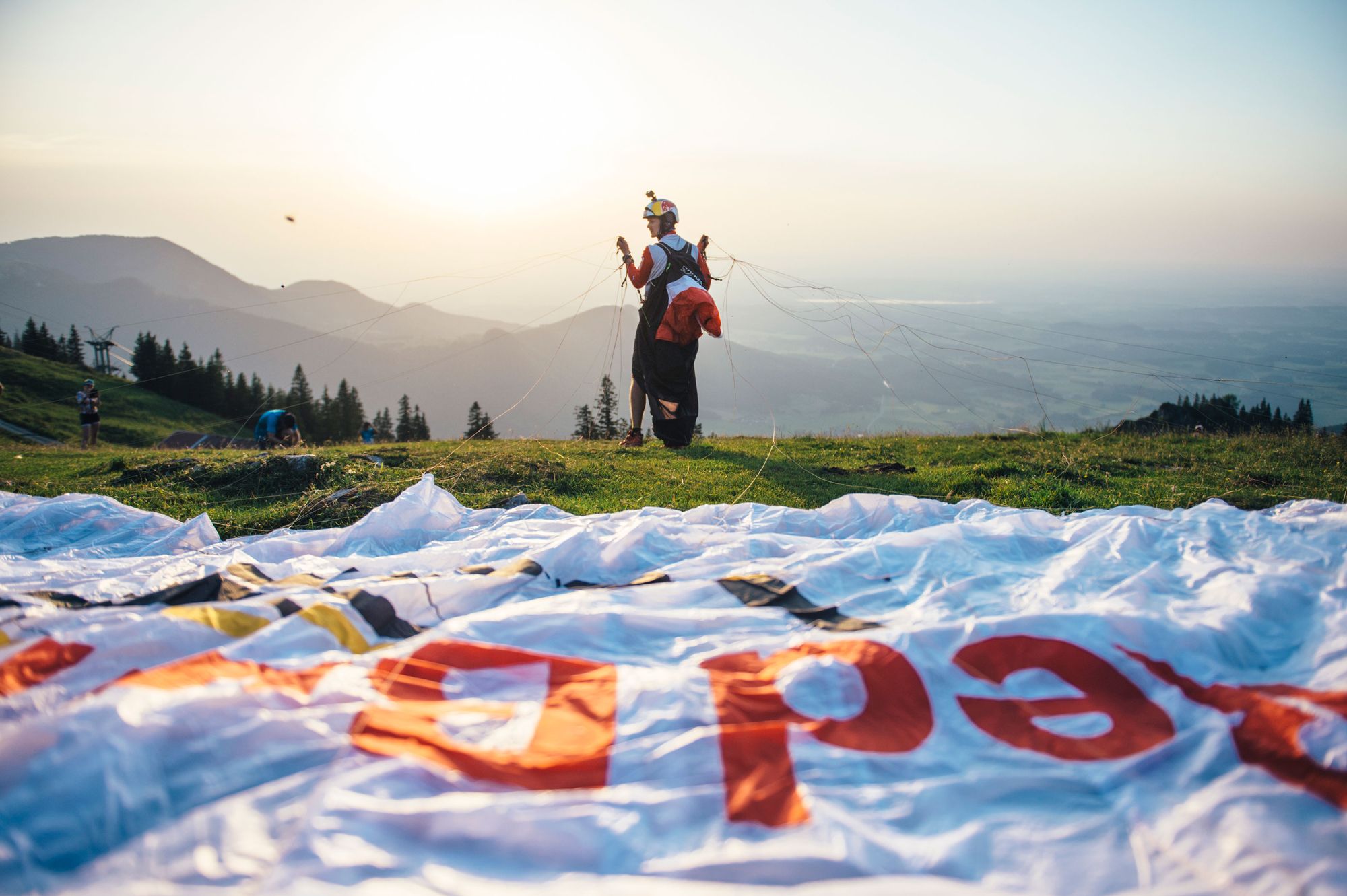
It is billed as the toughest adventure race on Earth. 32 athletes race over one thousand kilometers via a series of turn points from Salzburg to Monaco across the spine of the Alps. The race gets longer and more complicated and difficult with each edition, which takes place every two years, and first began in 2003. Progress is allowed only by air (by means of flying a paraglider) or by foot; athletes must carry their wing, harness, helmet, instruments and a handful of other mandatory equipment (safety flares, tracking device, etc.) across frozen glaciers, along congested motorways, suffer through blistering heat, snow and rain storms, and oxygen-starved frigid alpine environments. Depending on the weather some athletes will cover over 100 kilometers on the ground each day and will typically climb the height of Everest 4 times during the race. Every 48 hours whoever is in last place is eliminated and typically several athletes drop out of the race due to exhaustion, severe blisters or other injury. There are very few rules. Other than hitting the mandatory turn points athletes are allowed total freedom in how they navigate the course. Movement is allowed between 0530 and 2230 every day, with the exception of one “night pass” which every athlete can elect to use at any time during the race, which eliminates the mandatory rest period. Each athlete is allowed one official supporter, who can provide technical advice, and mental and nutritional support. In the history of the race only 11% of the field has finished. The combination of physical torture, lack of sleep, and dangerous flying conditions that only the most bold pilots in the world are willing to tackle certainly puts the race in a special category. But is it the “toughest adventure race on Earth”?
Lets take a look.

Adventure racing isn’t new. Humans have been devising creative ways of inducing severe physical and mental punishment for time immortal, but the birth of the modern adventure race is often credited to the two-day Karrimor International Mountain Marathon, an unsupported two-person double marathon through mountainous terrain, first held in 1968. Today there are ultrathons (100+ mile races) all over the world. From racing in 120F degree heat in the Badwater ultra marathon in Death Valley to the Marathon De Sables in the Sahara desert- both of which claim to be the hardest foot race on Earth; to the 146 mile bug-infested Jungle Ultra in Peru; to racing across the frozen wilderness of Alaska with no navigation aids in the Alaska Mountain Wilderness challenge, there is no shortage of proper sufferfests. Each of these races might take 3 or 4 days and while unremitting and certainly dangerous clearly don’t compare to the kind of distance, time, punishment and danger of flying and hiking across the Alps.
Longer, more demanding and dangerous races include the Iditarod Invitational, a 1,000 mile solo race by bike, foot or skis following the legendary Iditarod trail from Willow to Nome, Alaska. Long, cold and rugged, it is billed as the “world’s longest winter ultra marathon” and its lack of rules is similar to the X-Alps in that the athletes must make a myriad of decisions and live with the consequences. The fastest time it has been completed was 10 days, and in one year no one finished. A race with probably the lowest completion rate is the 6633 ultra, a self-supported 350 mile race along the arctic circle where participants tow a gear sled by foot. Athletes have to deal with temps that hover 25 degrees below zero, ferocious winds, and ruthless terrain. Runners are allowed 8 days to complete the event and only 11 participants have done so in the race’s seven year history.
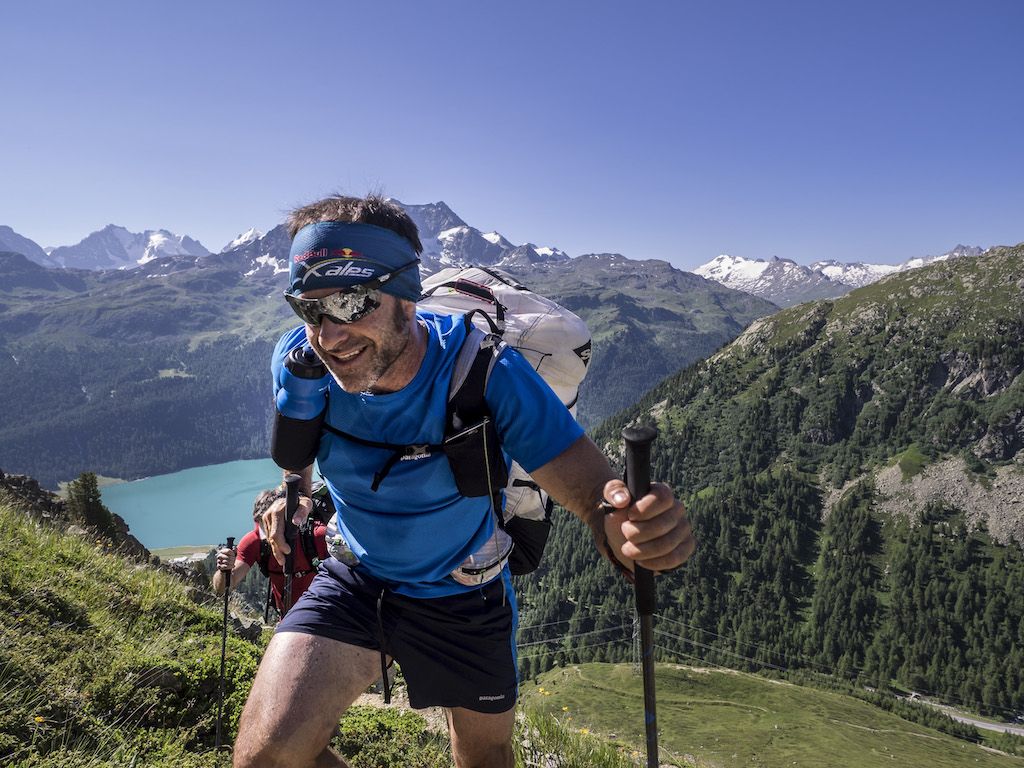
Weather is clearly a major factor in all of the hardest races, and the X-Alps is no exception, so the “toughest” in one year may not be the toughest in another year. The only race that may be on par from a danger level with the X-Alps is the Alaska Mountain Wilderness Challenge where a combination of fatigue, terrain and weather conspired to kill a highly skilled athlete in 2015 while attempting to fjord a river. Flying a paraglider is dangerous in the best of times, but during the X-Alps athletes become mentally exhausted and reaction times to potentially lethal situations in the air are compromised. All of these difficult and long adventure races are a matter of endurance and being able to withstand extreme physical hardship. The X-Alps has these elements in spades, but it is also a game of finesse and skill and tactics. You can’t muscle your way through the X-Alps, you have to think your way through, and this may be where the X-Alps stands alone. The fastest endurance trail runner in the world would have no chance in the X-Alps. You have to be fast on the ground, but you also have to be a fearless magician in the air. You can’t just put your head down and grunt it out. You have to think. Training for an endurance event that also encompasses the nuances and art of flying a piece of unmotorized plastic hundreds of miles across a mountain range must include training in conditions that can be expected in the race. These are conditions that even the best (and crazy) pilots in the world would not be willing to take on.
In the end, each of these races is a deeply personal experience lived, felt, agonized, triumphed or defeated by the athlete and the athlete alone. There is only one way to get to “that place.” The X-Alps is a one-way elevator that will take you there.
The big day finally arrived. Months and months of training and preparation and doubts and fears and excitement was now officially in the past. It was GO time. And it was excruciatingly hot. Thirty-two athletes were bunched under the huge Red Bull tent in downtown Salzburg hiding from a vicious sun. I drank a few more bottles of water and sank into a beanbag and shut my eyes, instantly falling asleep. I’d dreamt of this moment for so long it felt totally surreal to finally be here. I was unreasonably calm, I could feel my heart ticking away like it was just another day. I had been adding sleeping pills to my nightly routine all week in an effort to add some much-needed nocturnal rest, but they hadn’t worked.
I’d heard stories from some of the pilots who had competed in the race previously that they actually caught themselves dozing in flight. Others talked about hallucinations. Paragliding is intense even in calm conditions, I really hoped I didn’t get so sleep deprived that taking catnaps in the sky became necessary!My internal clock gave me a shake a few minutes before the start and then we were off, running through the cobbled streets of Salzburg with throngs of people cheering us on towards the first turn point, the Gaisberg.
As the ascent steepened the pace slowed and I checked my heart rate. I was using the Garmin Fenix watch (Garmin was a major sponsor of the race) and heart rate monitor instead of my trusty Suunto and hoped I had a setting or something wrong when it said my heart rate was 188! That was well above my maximum and totally untenable for any length of time. I felt great and couldn’t understand why it was beating so hard. Was it heat? Adrenaline? I knew I wasn’t going any harder than I had in training. But it didn’t drop. About six kilometers into the race I met up with one of my supporters, Ben, as planned, who had walked down from the launch with extra water and a few packets of Gu. I told Ben about my heart rate, which at that point had been above 180 for over 30 minutes. I was afraid I was going to bonk or just pass out, even though I felt fine. “What the hell is going on?” I asked.
“How do you feel?” Ben questioned.
“I feel great man, awesome. I’m worried my heart is going to explode, but it feels fine.”
“You’re fine then, you know your body and you know your heart rate better than any monitor does. Trust your training.”
This would be the first of literally hundreds of times Ben’s confidence would put my mind at ease. We rallied the rest of the way to launch, arriving in eighth place amongst a sea of screaming fans.
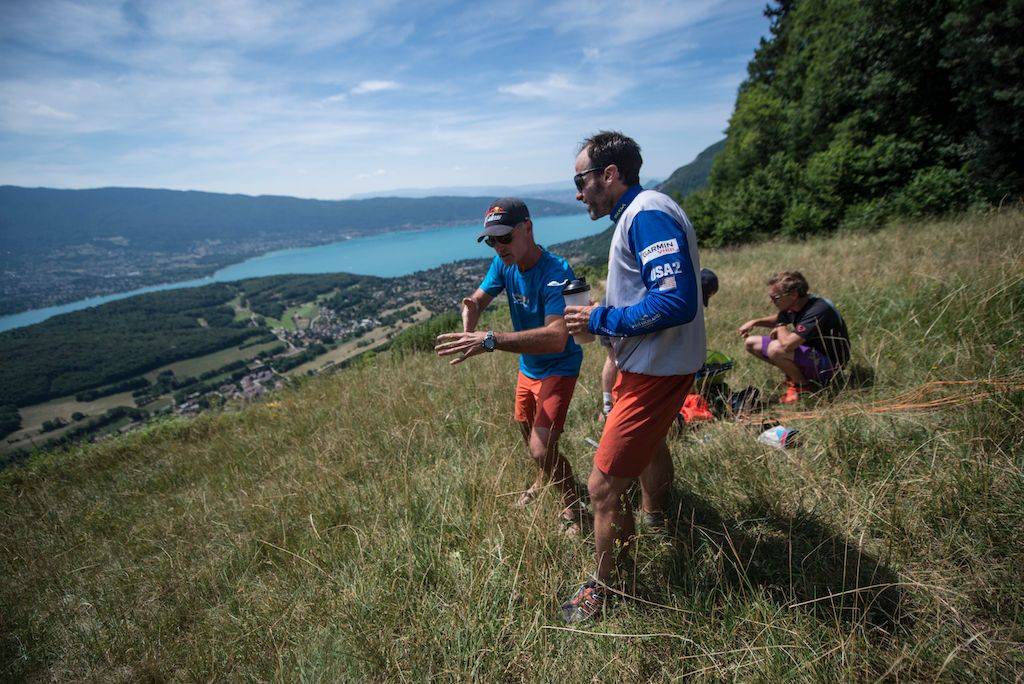
My team was ready with a big lunch, extra water and all the non-mandatory gear that I would take with me into the air. Crampons and via-ferrata harness for the Dachstein in case we had to hike to the 2nd turnpoint over the glacier instead of flying to it, extra clothing, a dry shirt, gloves, sun block and electrolytes. In this heat, water and electrolytes were critical and our biggest fear behind bombing out (landing prematurely) was bonking. Bruce (my tactician and air-strategist) refreshed me with the airspace regulations in the area. The airspace all the way to the Dachstein and then towards turnpoint 3 at Aschau is really tricky. Violating airspace meant at best a 24 hour penalty, and at worst a disqualification. Screw it up and the race is over.
I took stock of my surroundings. Throngs of screaming fans, the Red Bull filming helicopter buzzing loudly overhead, all the athletes laying out their gliders and preparing to fly. I was so excited and pumped up I felt like screaming, but I tried to keep a calm outer demeanor.
“Be cool Gavin, be cool!” I kept repeating to myself.
Then Nick Neynans (New Zealand) launched into the air, followed quickly by Aaron Durogati (Italy) and then the Eagle himself, Chrigel Maurer (Swiss 1). They were climbing easily. Time to go. I pulled my wing into the gentle breeze blowing up the hill, gave my team a nod and turned and lifted off the ground. Flight number one of the 2015 X-Alps! The plan was simple: Fly conservatively; stay in the air; don’t do anything stupid.
No less than twenty gliders climbed up to within a few hundred meters of prohibited air space and went on glide towards turnpoint 2, the stunning Dachstein, the highest mountain in Austria, 50 kilometers down course line. I counted maybe sixteen wings in front of me as I too went on glide, but chose a more direct line out front and began to quickly pick them off. I looked up at my wing and smiled. “Let’s go baby!”
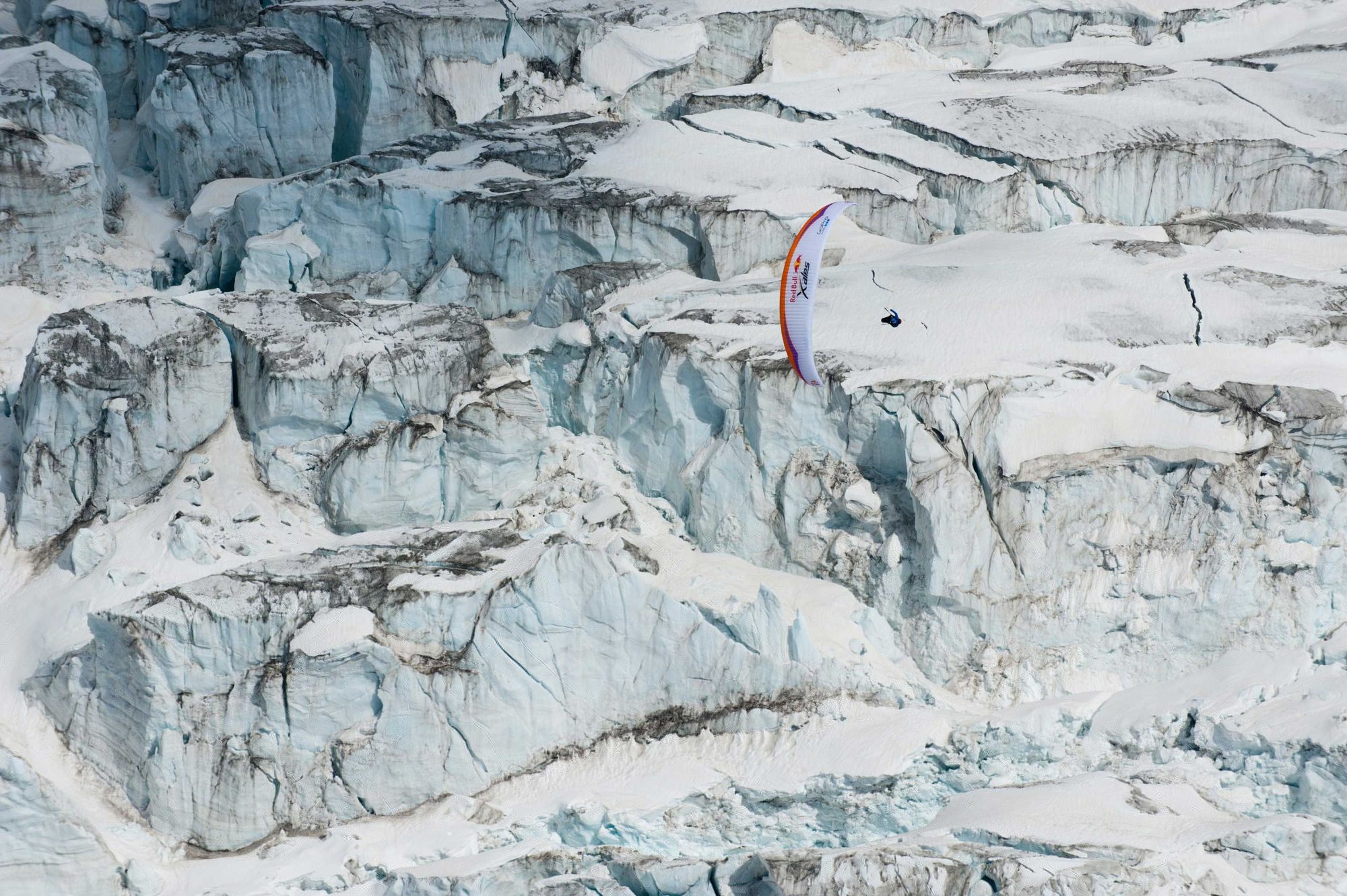
Twenty kilometers into the flight I’d pulled into 3rd place, behind Pascal Purin (Austria 4) and Maurer. Maurer was leading the charge as expected on a deep line but he was getting held up, so I stayed wide out front, linking onto a long spine that leads directly onto the Dachstein. We were in the big mountains now. The climbs were strong and the wind was light. A perfect flying day to start the race and the only real stress was staying below airspace. Nearly all of the pilots chose the deeper line behind Chrigel, and they were all higher than I was so I figured I must be OK. I liked my line better out front and in no time was coming in high over the glacier and the turn point, flying fast. I was in 4th place! What an amazing start!
The lead gaggle then broke up, nearly all the pilots headed southwest towards our planned route towards the town of Bischofshofen, where we could glide onto the impressive walls beneath the Hochkonig, which then lead to a very well-traveled glider “highway” that leads off in a northwest direction toward Turnpoint 3 in Germany. It was a route I’d flown twice during our scouting missions that spring and was the sensible way to go, but the conditions were so good I felt a more direct line was possible, shaving the corner and diving behind the Hochkonig. I set off on glide and was suddenly totally alone, right up in first place!
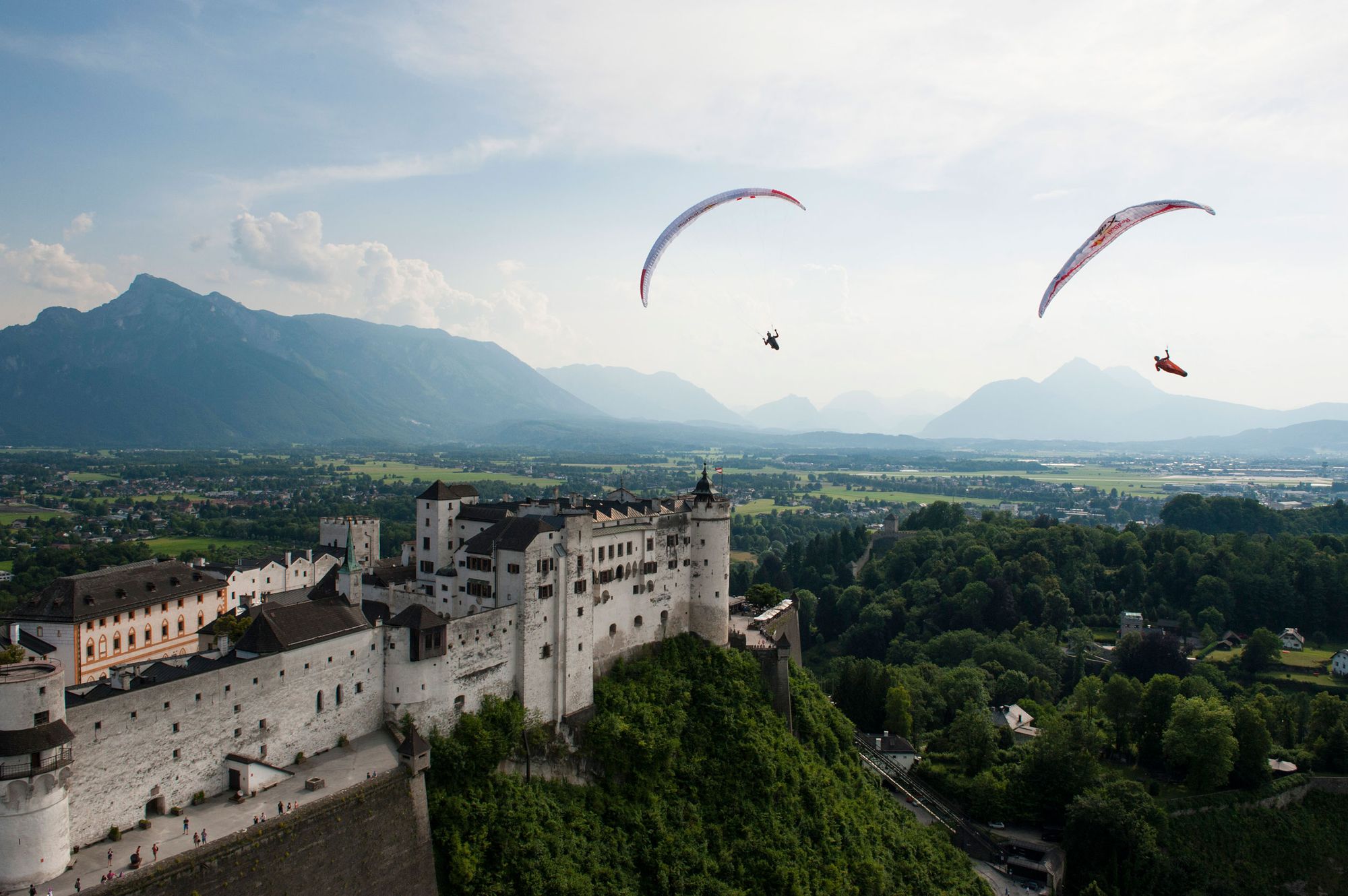
Even though I was in the lead I was starting to get nervous about my call to take the deeper line. But then I got jumped by Stephen Gruber (Austria 3), who was not only an amazing pilot but more importantly lived near here and knew this area probably better than anyone else in the field. Lead on! Then a wing I recognized was suddenly right next to me. Chrigel! He’d crawled up from way back in the pack after getting stuck before the Dachstein and was skillfully picking off pilots one by one. He looked up and while I couldn’t see his face I knew he was smiling and then he seemed to find another gear and accelerated past me like I was standing still. You son of a bitch!!! But knowing Chrigel was taking the same line gave me a huge boost in confidence and I set off, trying to reel him in. The Red Bull helicopter swept in to film the lead three pilots as we found our next climb. You couldn’t have wiped the smile off my face with a cheese grater. The Aschau turn point was only 70 kilometers away and I was in the top three! If we could stay in the air we could cover 15% of the course on the first day! We were high, the flying was magnificent, the scenery mind-blowing and I thought that it was doubtful anyone on Earth was having more fun than I was at that moment.
At 1900 hours Bruce called with a strategy update.
“Gavin you need to slow down now, stay high, stay in the air. Change gears, stop racing, STAY IN THE FUCKING AIR, I don’t want you to land until 9 pm!”The race rules allowed us to move between 05:30 and 22:30 hours, but we could only fly between 06:00 and 21:00.
I limped onto a shaded hill above a lake and thought my day was over but as I ground around to the west still-sunny side found an agonizingly slow climb. I worked ever-so-slowly higher and just as I got to where I could have some breathing room Paul Guschlbauer (Austria 1) flew right over my head and lead the way.
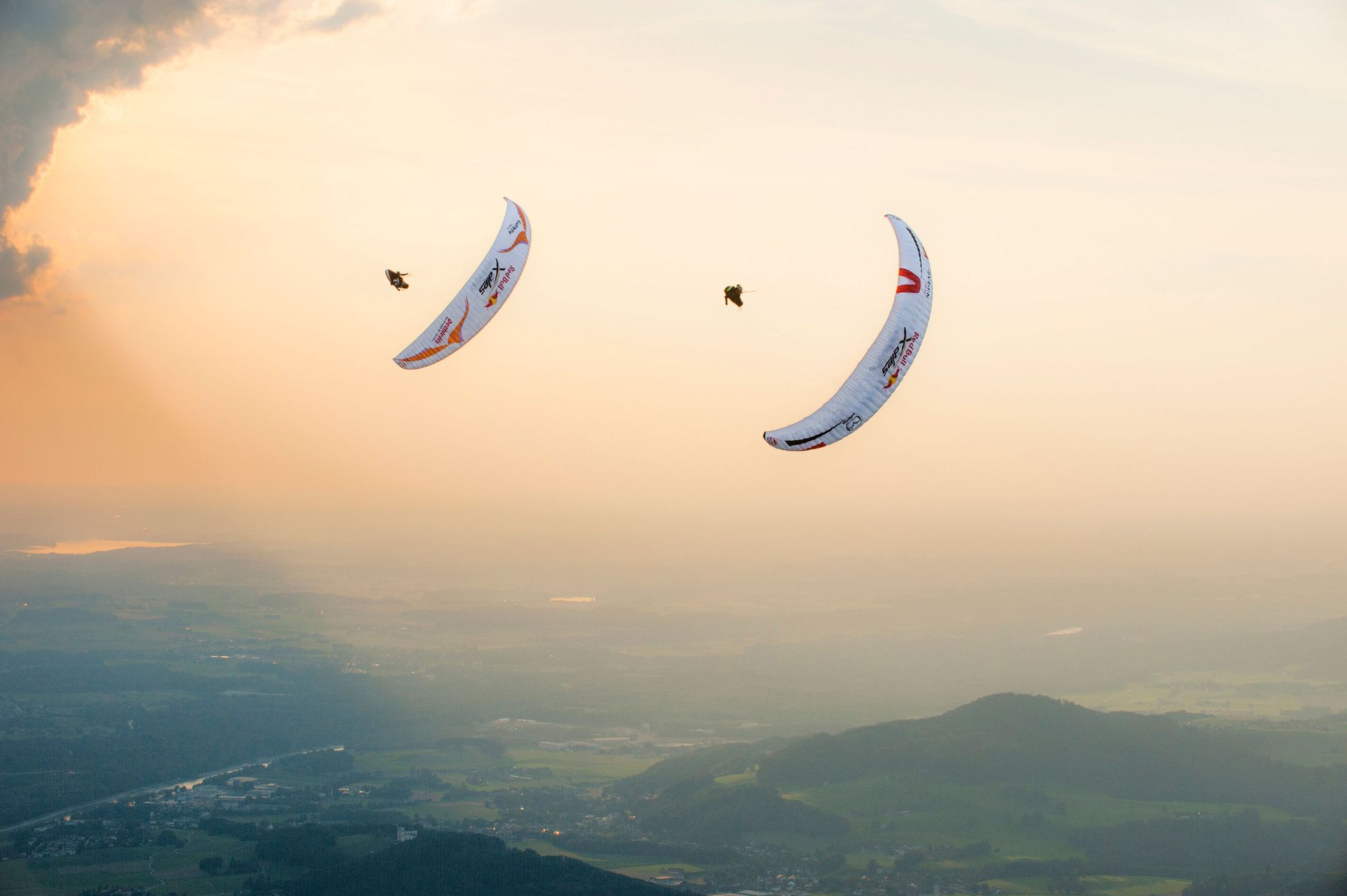
We squeaked over a treed col to the east of a small town called Unterwossen and landed near a small airstrip just after 8 pm, just a few kilometers short of turnpoint 3 at Aschau in Germany. 170 kilometers of the 1100 kilometer course had just been covered in the air. As soon as I landed I started ripping off my gear and throwing it around instead of neatly piling it as I’d practiced so many times. Bruce called and I impatiently tried to give him directions to where I was, but he had no cell data and couldn’t pull up Google Maps and I just said “goddammit, I’m on the airstrip, come find me!” and hung up. I packed up my wing, lost my bluetooth earpiece in the grass and ran off in the wrong direction. A woman ran out from her house and offered me some food and asked where I was going, and handed me a glove that I’d dropped. I’d been running towards the turn point but hadn’t noticed a large river blocking my path because I hadn’t taken the time to check my maps. The woman said I either had to wade across or backtrack a kilometer to the main road. I thanked her for the food, grabbed my glove and ran back the way I’d come cursing myself for being so hasty and unorganized. I was making a rookie mistake that we’d been warned not to do.
Our beautiful van, easily recognizable with the huge Patagonia stickers pulled up and Bruce and Ben hopped out wearing big smiles. I was handed an energy shake and we briefly discussed strategy. I was in 4th place. I knew there was a hotel at the turnpoint and Ben and I raced off thinking there was something to be gained by hauling ass. There wasn’t. It was our team’s first big lesson of the race. SLOW DOWN. In our rush we forgot spare batteries and chargers; my mouthguard which I can’t sleep without; money for the hotel or dinner; and appropriate clothing for the storm that was on its way, which we knew nothing about.
That night as the wind howled and the rain thundered down relentlessly and sleep stayed out of reach I replayed the events of the day in my mind and imagined the days ahead. I didn’t know it of course at the time, but I would finish in a respectable 8th place and be the first American to reach Monaco in the race’s history. In ten days I would cover 498 kilometers on the ground (12+ marathons), climb and absurd 52,000 vertical meters (Everest 5 times) and fly 1560 kilometers across one of the most iconic and stunning mountain ranges in the world.
I would have some of the most memorable flights of my career. Some beautiful, some terrifying. But that night, even though the race had barely begun it was already was more adventure, more fun, more difficult and more terrifying than anything I’d ever done. In the days ahead I would learn you had to give it everything you had. You had to risk it all. You had to think with an exhausted mind and you had to move fast with an exhausted body. You had to ignore pain.
You had to have an awesome team who could stay optimistic and solve the plethora of problems that came up on the fly. All the logistics and strategy and being there for me whenever I needed them, at any time of the day or night; anticipating my every move; figuring out routes; keeping me fed; working out weather forecasts; keeping my instruments charged; and making sure I didn’t forget anything.
That night I should have dreamt of Monaco but instead I worried about the inevitable. At some point the race would end. At some point the magic that we were experiencing would come to an abrupt halt. We had poured our lives into this race for the better part of a year and in one moment it would be over. We had 865 kilometers to go, the most difficult and dangerous part of the course was ahead but that wasn’t what was on my mind that night. What was on my mind made me sad because I knew that when this craziness ended I would no longer have the precious gift that the race had given me. The gift of being right here, right now. Kung Fu Panda said it best: “yesterday is history, tomorrow is a mystery, but today is a gift. That’s why it is called a Present.”
Did Gavin inspire you to go take a hike! (Or a climb)? Head to The Outdoor Voyage to make your own story.
This article was a feature in Issue 10 of The Outdoor Journal print magazine and can be seen on Gavin's website, Cloudbase Mayhem.
2nd best newsletter in the universe